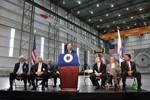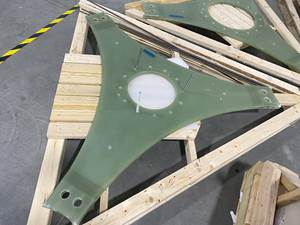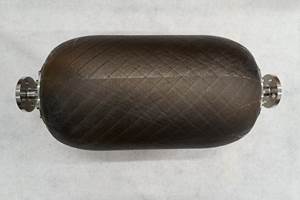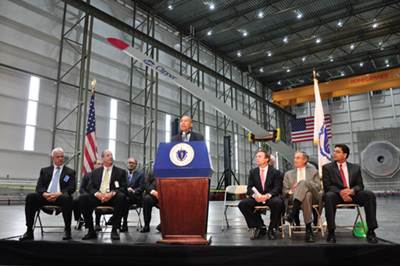In Europe: Fraunhofer-IWES, NaREC Take Blade testing to 100m/328 ft
Two rotor blade testing facilities in Europe have answered the call for testing capability that will accommodate today’s longer blade designs for offshore wind turbines with newly constructed blade test sites.Fraunhofer-Institut für Windenergie und Energiesystemtechnik (IWES, Bremerhaven, Germany), the first to complete its expanded facility, is now able to test 90m/295-ft blades, up from 70m/230-ft test lengths two years ago.
Two rotor blade testing facilities in Europe have answered the call for testing capability that will accommodate today’s longer blade designs for offshore wind turbines with newly constructed blade test sites.
Fraunhofer-Institut für Windenergie und Energiesystemtechnik (IWES, Bremerhaven, Germany), the first to complete its expanded facility, is now able to test 90m/295-ft blades, up from 70m/230-ft test lengths two years ago. Fraunhofer-IWES’s new test equipment is housed in a recently completed €11 million ($14.3 million USD) testing hall funded by Germany’s Federal Ministry of Education and Research (BMBF); the Federal Ministry for the Environment, Nature Conservation and Nuclear Safety (BMU); the European Regional Development Fund (EFRD); and the state of Bremen, Germany.
Blades are attached to a massive 1,000 metric tonne/2.2 million lb tiltable mounting block made of steel and reinforced concrete, with dimensions of 14m by 12m by 12.5m (45.9 ft by 39.4 ft by 41 ft). Because the mounting block can tilt up to minus 20° from vertical, even very long blades can be displaced to the appropriate levels (see the discussion of tip deflection and its relationship to blade angle in the main article, under "Editor's Picks," at top right).
The ability to rotate the mounting block allows test technicians to accelerate the testing procedure and affords greater flexibility in adjusting the mounting angle of the rotor blade during testing. During a static test, as the rotor blade is loaded with cables, it can be simultaneously tilted by hydraulics mounted to the tilt block.
During static loading, the force applied to the blade from each hydraulic cylinder is controlled using a load cell placed between the blade and the loading cable. This setup enables Fraunhofer-IWES personnel to precisely control the loads and subsequent deformations and strains of the blade throughout a testing regime.
For dynamic fatigue tests, the rotor blade can be loaded in vertical and horizontal directions. The distribution of the bending moment along the rotor blade can be adjusted by varying the test frequency or adding weights. For dynamic tests at the first eigenfrequency, the energy requirement is reduced compared to quasi-static fatigue tests. Fraunhofer-IWES has developed new methods for biaxial fatigue tests that allow simultaneous loading in the flap and edge directions. This test method reportedly reduces the test duration and costs, and provides a more realistic load situation.
Through measurement and frequency analyses, the rotor blade’s eigenfrequencies can be determined. Hundreds of strain gauges, load cells, cable sensors, angle sensors and sensors capable of measuring variously acceleration, temperature and humidity are said to generate a wealth of data for analysis. In addition to its facilities for testing full-scale rotor blades, the laboratory infrastructure includes facilities for coupon and component testing, providing characteristic values for the evaluation and development of rotor blade substructures.
Similarly, the not-for-profit National Renewable Energy Centre (NaREC, Blyth, Northumberland, U.K.) now has the capability to test blades up to 100m/328-ft long. The new blade testing hall is 123m/403.4 ft long and is housed within the 5,700m2 (61,354 ft2) steel frame building at NaREC. The new building is reportedly the second of three structures to be completed at Blyth as part of a more than £80 million ($128 million) investment by NaREC in accelerated testing of offshore wind turbine blades and other renewable marine energy technologies.
The test hub is a 15m/49.2 ft high concrete superstructure on a “substantial” foundation. It features two huge blade attachment rings. The top ring, 8m/26.3-ft in diameter, is said to accommodates blade lengths up to 100m/328 ft. The bottom ring accommodates blades of smaller root diameters. The hub arm includes substantial foundations. To achieve the exact position of the rings within the concrete structure, 216 post-tensioned bars have been cast in to extremely tight tolerances of ±3 mm (0.118 inch). Special winches, fixed to 132 circular steel rings in the floor, also have been manufactured and will be used to flex the blades during testing.
NaREC also incorporates a facility that is capable of testing blades up to 50m/164 ft in length, in accordance with IEC and ISO standards or customer requirements. Dynamic and static tests are undertaken and can include the determination of natural frequencies, modal analysis, postfatigue and failure assessments. This ISO 17025-certified lab has been in operation for seven years.
The new facility is being commissioned and accredited to ISO 17025 standards. It was jointly funded by the U.K. Department for Business, Innovation and Skills and the U.K. Department of Energy and Climate Change (£11.5 million/$18.4 million), Regional Development Agency One North East (£2 million/$3.2 million) and the ERDF, managed in the U.K. by the Department for Communities and Local Government, which secured a £4.7 million/$7.5 million ERDF investment.
NaREC was established in 2002 as a Center of Excellence for new and renewable energy technologies. It is, therefore, a collection of research, testing and development facilities across the spectrum of the renewable energy sector. It offers not only testing and prototyping of large on- and offshore wind turbine blades, but also tidal turbines and other subsea equipment, micro-renewables and high-voltage electrical equipment. NaREC also has facilities and consultancy expertise for the development and integration of large- and small-scale renewables into the energy mix, including assistance with small-scale embedded power generation and systems analysis services. Further, NaREC has the oversight of what it says is the U.K.’s only independent photovoltaic (solar energy) R&D laboratory, which is capable of small-scale manufacturing and solar cell process development.
Related Content
Infinite Composites: Type V tanks for space, hydrogen, automotive and more
After a decade of proving its linerless, weight-saving composite tanks with NASA and more than 30 aerospace companies, this CryoSphere pioneer is scaling for growth in commercial space and sustainable transportation on Earth.
Read MoreRTM, dry braided fabric enable faster, cost-effective manufacture for hydrokinetic turbine components
Switching from prepreg to RTM led to significant time and cost savings for the manufacture of fiberglass struts and complex carbon fiber composite foils that power ORPC’s RivGen systems.
Read MoreNCC reaches milestone in composite cryogenic hydrogen program
The National Composites Centre is testing composite cryogenic storage tank demonstrators with increasing complexity, to support U.K. transition to the hydrogen economy.
Read MoreJEC World 2023 highlights: Recyclable resins, renewable energy solutions, award-winning automotive
CW technical editor Hannah Mason recaps some of the technology on display at JEC World, including natural, bio-based or recyclable materials solutions, innovative automotive and renewable energy components and more.
Read MoreRead Next
WTTC opens upsized wind blade test facility
The Wind Technology Testing Center (WTTC, Boston, Mass.) opened its $35 million+ wind blade testing facility on May 18, 2011, the only lab in the U.S. that can test blades up to 90m/295-ft long.
Read More“Structured air” TPS safeguards composite structures
Powered by an 85% air/15% pure polyimide aerogel, Blueshift’s novel material system protects structures during transient thermal events from -200°C to beyond 2400°C for rockets, battery boxes and more.
Read MoreVIDEO: High-volume processing for fiberglass components
Cannon Ergos, a company specializing in high-ton presses and equipment for composites fabrication and plastics processing, displayed automotive and industrial components at CAMX 2024.
Read More















.jpg;maxWidth=300;quality=90)








